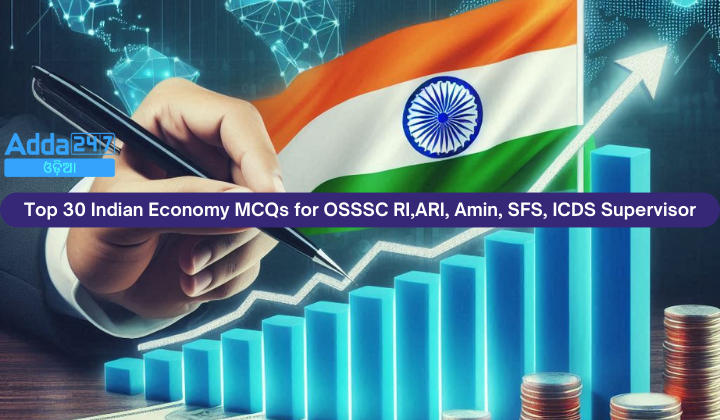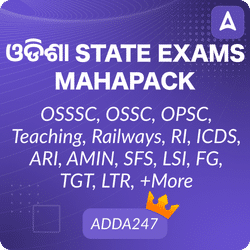Preparing for the OSSSC RI, ARI, Amin, SFS, and ICDS Supervisor exams requires a solid understanding of the Indian economy. These competitive exams often feature questions on economic concepts, policies, and current trends. A focused study of the top 30 multiple-choice questions (MCQs) can significantly enhance your readiness. These questions cover critical topics such as GDP growth, inflation, fiscal policy, banking reforms, and trade. They are tailored to align with the exam pattern, helping candidates gain a comprehensive overview and practice efficiently for their upcoming assessments.
Top 30 Indian Economy MCQs for OSSSC RI,ARI, Amin, SFS, ICDS Supervisor
1. Interest rate risk can be categorized under which of the following?
(a) Credit risk
(b) Market risk
(c) Operating risk
(d) All of the above
Ans: (b) Market risk
2. “Circuit Breakers” in share markets halt trading on which occasion?
(a) On special days
(b) When a new share is traded for the first time
(c) When the price of a particular stock rises or falls by a specified amount in a specified time
(d) When the trading volume of a particular stock exceeds a specified level
Ans: (c) When the price of a particular stock rises or falls by a specified amount in a specified time
3. The concept of weaker sections under ‘priority sector’ was introduced by which committee?
(a) Krishnaswami Committee
(b) Varshney Committee
(c) Gadgil Committee
(d) Abid Hussain Committee
Ans: (a) Krishnaswami Committee
4. An agreement to exchange floating rate payments for fixed rate payments is known as:
(a) Currency Swap
(b) Interest Rate Swap
(c) Rolling Settlement
(d) Arbitration
Ans: (b) Interest Rate Swap
5. In which year was the Tax Reforms Committee constituted by the Government of India?
(a) 1975
(b) 1980
(c) 1991
(d) 1995
Ans: (c) 1991
6. When did India ratify the International Covenant on Economic, Social, and Cultural Rights?
(a) 1979
(b) 1985
(c) 1998
(d) 2000
Ans: (a) 1979
7. Which sector uses the maximum commercial energy in India?
(a) Household sector
(b) Agriculture
(c) Industries
(d) Transport
Ans: (c) Industries
8. What is the share of the Government of India in NABARD?
(a) 50%
(b) 51%
(c) 75%
(d) 99%
Ans: (d) 99%
9. The term used for the maximum capital a company can raise in its lifetime is:
(a) Authorized Capital
(b) Registered Capital
(c) Nominal Capital
(d) All of the above
Ans: (d) All of the above
10. A manufacturing unit is considered a micro-enterprise if its investment in plant and machinery does not exceed:
(a) Rs. 10 Lakh
(b) Rs. 15 Lakh
(c) Rs. 25 Lakh
(d) Rs. 35 Lakh
Ans: (c) Rs. 25 Lakh
11. The surge in India’s e-commerce sector is mainly driven by:
(a) Increased internet penetration
(b) High smartphone prices
(c) Limited internet services
(d) Decrease in rural population
Ans: (a) Increased internet penetration
12. India’s dependence on Chinese imports is highlighted by a significant increase in the import bill to:
(a) $70 billion
(b) $85 billion
(c) $101 billion
(d) $120 billion
Ans: (c) $101 billion
13. In 2022, India emerged as the global leader in:
(a) Solar energy generation
(b) Wind energy deployment
(c) Remittances
(d) Industrial exports
Ans: (c) Remittances
14. India became the world’s third-largest solar power generator by surpassing which country in 2023?
(a) Germany
(b) Japan
(c) China
(d) USA
Ans: (b) Japan
15. The government of India allocated how much for the IndiaAI Mission?
(a) Rs. 5000 crore
(b) Rs. 7500 crore
(c) Rs. 10,300 crore
(d) Rs. 12,500 crore
Ans: (c) Rs. 10,300 crore
16. Which term refers to the practice of defining pre-determined values in percentage terms to halt trading?
(a) Trading halt
(b) Circuit Breaker
(c) Market pause
(d) Trading freeze
Ans: (b) Circuit Breaker
17. What is the primary role of NABARD?
(a) Provide loans to IT companies
(b) Promote agriculture and rural development
(c) Regulate stock exchanges
(d) Manage foreign exchange reserves
Ans: (b) Promote agriculture and rural development
18. The main focus of the IndiaAI Mission is:
(a) AI research and innovation
(b) Traditional agriculture
(c) Solar energy development
(d) Export regulations
Ans: (a) AI research and innovation
19. India ratified the International Covenant on Economic, Social, and Cultural Rights in which year?
(a) 1985
(b) 1979
(c) 1998
(d) 2000
Ans: (b) 1979
20. Which committee is associated with the introduction of the term ‘Priority Sector Lending’?
(a) Abid Hussain Committee
(b) Gadgil Committee
(c) Varshney Committee
(d) Krishnaswami Committee
Ans: (d) Krishnaswami Committee
21. What term is used to describe the maximum capital a company can legally raise?
(a) Issued Capital
(b) Paid-up Capital
(c) Authorized Capital
(d) Subscribed Capital
Ans: (c) Authorized Capital
22. The Tax Reforms Committee of India was established in:
(a) 1975
(b) 1980
(c) 1991
(d) 1995
Ans: (c) 1991
23. India is the largest recipient of remittances surpassing how much in 2022?
(a) $50 billion
(b) $75 billion
(c) $100 billion
(d) $111 billion
Ans: (d) $111 billion
24. What percentage of NABARD is owned by the Government of India?
(a) 50%
(b) 51%
(c) 75%
(d) 99%
Ans: (d) 99%
25. An agreement to swap payments from a floating rate to a fixed rate is known as:
(a) Equity Swap
(b) Interest Rate Swap
(c) Currency Swap
(d) Commodity Swap
Ans: (b) Interest Rate Swap
26. Which sector is the largest consumer of commercial energy in India?
(a) Agriculture
(b) Transport
(c) Household
(d) Industries
Ans: (d) Industries
27. The main document that authorizes a company to raise a certain amount of capital is called:
(a) Capital Certificate
(b) Memorandum of Association
(c) Articles of Association
(d) Certificate of Incorporation
Ans: (b) Memorandum of Association
28. The term “Authorized Capital” refers to:
(a) Capital issued to shareholders
(b) Capital that can be legally raised by the company
(c) Capital invested in machinery
(d) None of the above
Ans: (b) Capital that can be legally raised by the company
29. Which report highlights India’s dependence on Chinese imports?
(a) World Bank Report
(b) IMF Report
(c) Global Trade Research Initiative Report
(d) WTO Report
Ans: (c) Global Trade Research Initiative Report
30. Which of the following is the correct year when India’s merchandise exports increased by 1%?
(a) 2022
(b) 2023
(c) 2024
(d) 2025
Ans: (c) 2024















